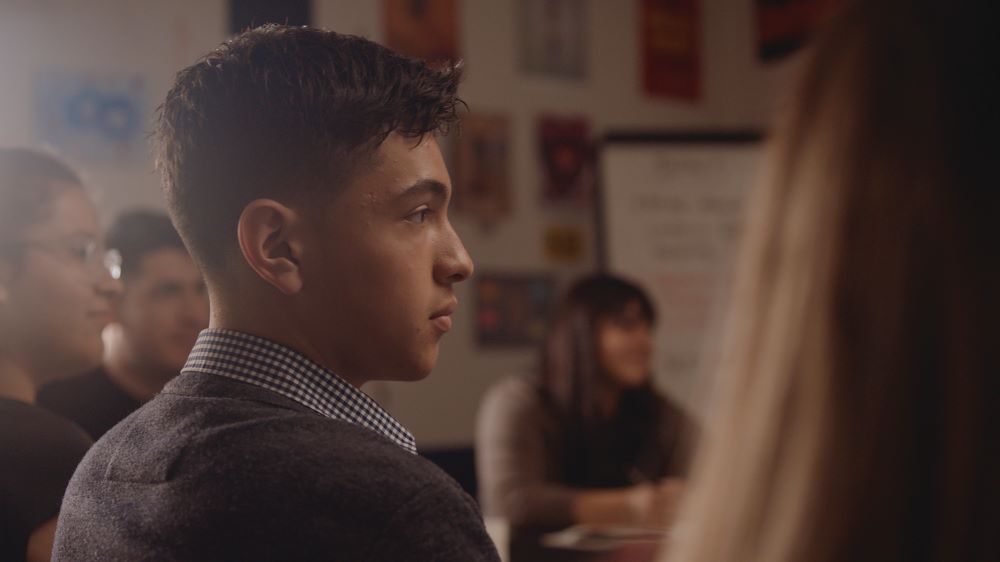Adding Drama to Interiors With Lighting
Some go-to techniques for interior lighting

There are reasons we light—to add shape, separation, draw the audience’s eye, create a mood and so much more. More often than not, we change lighting in the shooting location to achieve these. There are a few go-to techniques that can really help add shape and direction within interior spaces, most of which are taking away certain sources that already exist and enhancing or extending others. The two examples below are very similar in method but different in their goals.
MAINTAINING AMBIENCE
The first example is a project that went to broadcast where we shot a few different subjects in their homes and then everyone together in the headquarters of the non-profit they were all a part of. The setting was a typical office space with fluorescent bulbs lighting the room from above with one window near the entrance. Without changing anything, it was a flat, harsh look with colors that did not mix well. We had to capture them in real time as if we were capturing a documentary or news piece that was very noninvasive.
With time to plan before the group had their meeting, the crew went into the room and rigged a Litegear LiteMat 4 above the conference table, threw a K5600 Joker 800 through that single window that would mostly be off-screen and turned off all the house lights. This transformed the room, adding contrast and dimension; yet, because of the top light, maintained enough ambience to avoid being too dark.
Overall, the scene felt naturalistic for the documentary-style piece, but slightly more stylized and flattering. We could not affect the layout or items in the office either—we had to choose where to mostly point the camera so as to maintain that look while still showing as much of the room as possible.
MAINTAINING AUTHENTICITY
For a series of PSAs that also went to TV, we wanted to add a specific, dramatic tone to the visuals while still maintaining a sense of authenticity—a combination that I strive for often.
There were a few different concepts that were executed but one I thought was particularly interesting was that of a school shooting simulation: Students are hiding beneath their desks and there’s a suspenseful, dangerous tone we wanted to communicate.
The classroom had white walls so to begin, production design elements came in to take away the ambience. House lights were turned off and HMIs were lined against the single wall with windows. Most of them came down onto the tables and bounced off the floors to illuminate faces. One even kicked the back wall, adding a highlight. They were a combination of a few 1600W HMI fresnels and a 4K HMI. When walking in for close-ups, we would simply cheat the subject somewhere slightly different to create a better shot.
The professional video industry's #1 source for news, trends and product and tech information. Sign up below.

FLEXIBLE SHOOTING
Both examples allowed for flexible shooting as well in each location, which, for a more naturalistic-looking approach, is ideal. Sometimes we’ll be asked to allow subjects to be able to move around a space freely, without lighting having to be altered. Offering to bring in a little additional lighting or grip to tweak a close-up or other additional shot is helpful if you can pause the action, as in the school PSA. For a live meeting though, as in the first example, the action cannot be interrupted, so being able to “set it and forget it” was key.
In both instances, we were dealing with serious subject matter and adding contrast and direction in the images was really important. While one was more extreme than others, it was really about adding direction to the light in each scene and then deciding how much ambient fill existed.
Approaching lighting in a more minimalistic way tends to speed things up and keep the onscreen tone authentic. This is true from narrative to television. Even in news, lighting is more and more sophisticated. It is a matter of focusing on the story in every format and understanding how to use available light or how to replace it.
Though our camera technology is evolving rapidly and is getting significantly better at capturing a range of light readings without losing information, the need to actually shape light in locations and paint the frame will never go away.
Julia Swain is a cinematographer whose work includes films such as “Lucky” and “Speed of Life” alongside dozens of commercials and music videos. She continues to shoot on a variety of formats, seeking to create compelling visuals for every story and brand.
